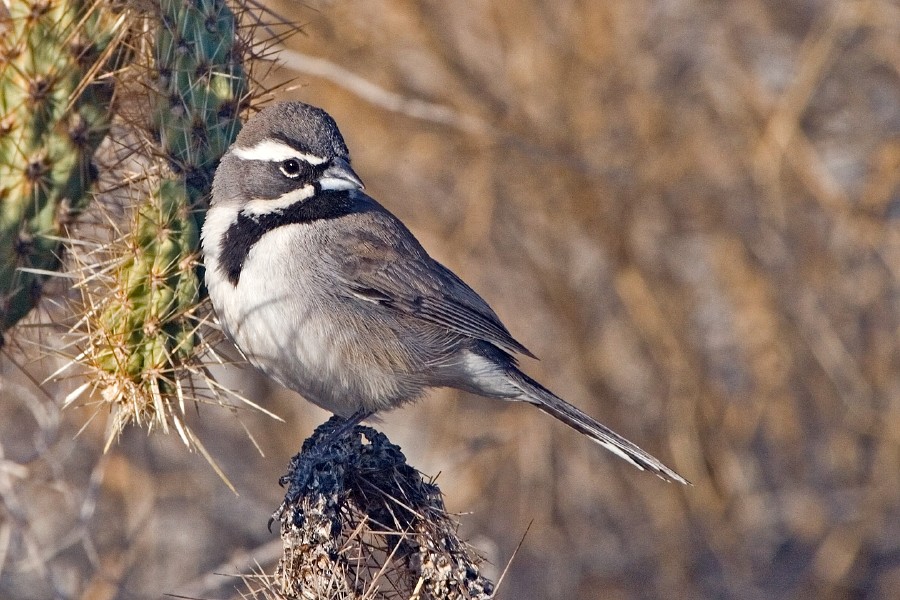Black-throated Sparrow
A species of Black-throated Sparrows Scientific name : Amphispiza bilineata Genus : Black-throated Sparrows
Black-throated Sparrow, A species of Black-throated Sparrows
Botanical name: Amphispiza bilineata
Genus: Black-throated Sparrows
Content
Description General Info
 Photo By Elaine R. Wilson , used under CC-BY-SA-2.5 /Cropped and compressed from original
Photo By Elaine R. Wilson , used under CC-BY-SA-2.5 /Cropped and compressed from original Description
Measurements: Length: 4.7-5.5 in (12-14 cm) Weight: 0.4-0.5 oz (11-15 g) Wingspan: 7.7 in (19.5 cm) The black-throated sparrow is pale gray above, with a distinctive black and white head pattern. Immature birds are similar but lack a black throat. Its call is high and bell-like, and its song is a fairly simple, mechanical tinkling. It feeds primarily on insects and seeds, and travels in small groups, though larger groups may accumulate around sources of water in the desert. It has a loose nest of grass twigs and plant fibers carefully hidden in brush 6–18 inches (15–46 cm) above the ground. Three or four white or pale blue eggs are laid. 
Size
14 cm (5.5 in)
Life Expectancy
6 years
Nest Placement
Shrub
Clutch Size
2 - 5 eggs
Incubation Period
1 - 2 broods
Number of Broods
11 - 13 days
Nestling Period
9 - 10 days
Feeding Habits
Black-throated Sparrow predominantly feed on the ground, near or under shrubbery. They forage for butterfly and moth larvae, mantids, robber flies, dragonflies, and walking sticks during breeding. In nonbreeding seasons, their diet shifts mainly to seeds, with occasional insect consumption.
Habitat
Black-throated Sparrow primarily dwells in arid regions, favoring semiopen landscapes with shrubs and sparse trees ranging from 3 to 10 feet high. The species is prevalent in desert canyons, washes, and scrublands rich in creosote, ocotillo, cholla, acacia, sagebrush, mesquite, and rabbitbrush. While typically associated with lower elevations, they do inhabit areas up to 7,000 feet, including pinyon-juniper woodlands.
Nest Behavior
Black-throated Sparrow nesting behavior includes building nests shielded from intense sunlight. Females manage nest construction and egg incubation, while both parents contribute to feeding and caring for the young.
Nest Characteristics
Black-throated Sparrow typically build nests in desert shrubs or cacti about 1 foot off the ground to obtain morning sun and afternoon shade. Nests are cup-shaped, made from grasses, stems, and rootlets, and lined with finer grasses and animal hair.
Dite type
Insectivorous
General Info
Feeding Habits
Bird food type
Bird Feeder Type

Ground

Platform
Sounds
Song
Recording location: United States
Song
Recording location: United States
Behavior
Black-throated Sparrow exhibit a daily routine that includes hopping across the terrain to forage for insects and seeds, interspersed with brief, low-altitude flights across their arid scrubland habitat. Vigilant during breeding, they defend territories against intruders with bold songs and displays of fluffed feathers, reverting to chase if the warning is unheeded. Post-breeding season brings a shift in disposition, leading to the formation of small, communal foraging groups.
Species Status
Not globally threatened.
Scientific Classification
Phylum
Chordates Class
Birds Order
Perching birds Family
New world sparrows Genus
Black-throated Sparrows Species
Black-throated Sparrow